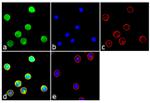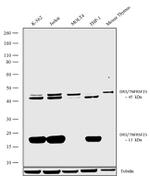FIGURE: 1 / 3
DR3 Antibody (702277) in ICC/IF



Product Details
702277
Species Reactivity
Host/Isotype
Expression System
Class
Type
Clone
Immunogen
Conjugate
Form
Concentration
Purification
Storage buffer
Contains
Storage conditions
Shipping conditions
RRID
Product Specific Information
This antibody is predicted to react with Monkey, Cat, Pig and Bovine.
Recombinant rabbit monoclonal antibodies are produced using in vitro expression systems. The expression systems are developed by cloning in the specific antibody DNA sequences from immunoreactive rabbits. Then, individual clones are screened to select the best candidates for production. The advantages of using recombinant rabbit monoclonal antibodies include: better specificity and sensitivity, lot-to-lot consistency, animal origin-free formulations, and broader immunoreactivity to diverse targets due to larger rabbit immune repertoire.
Target Information
DR3/TNFRSF25 is a member of the TNF-receptor superfamily. This receptor is expressed preferentially in the tissues enriched in lymphocytes, and it may play a role in regulating lymphocyte homeostasis. This receptor has been shown to stimulate NF-kappa B activity and regulate cell apoptosis. The signal transduction of this receptor is mediated by various death domain containing adaptor proteins. Knockout studies in mice suggested the role of DR3/TNFRSF25 in the removal of self-reactive T cells in the thymus. Multiple alternatively spliced transcript variants of this gene encoding distinct isoforms have been reported, most of which are potentially secreted molecules. The alternative splicing of this gene in B and T cells encounters a programmed change upon T-cell activation, which predominantly produces full-length, membrane bound isoforms, and is thought to be involved in controlling lymphocyte proliferation induced by T-cell activation.
For Research Use Only. Not for use in diagnostic procedures. Not for resale without express authorization.
References (0)
Bioinformatics
Protein Aliases: Apo-3; apoptosis inducing receptor; Apoptosis-inducing receptor AIR; Apoptosis-mediating receptor DR3; Apoptosis-mediating receptor TRAMP; death domain receptor 3 soluble form; Death receptor 3; death receptor beta; LARD; Lymphocyte-associated receptor of death; Protein WSL; Protein WSL-1; RP4-650H14.2; Tumor necrosis factor receptor superfamily member 25; tumor necrosis factor receptor superfamily, member 12; tumor necrosis factor receptor superfamily, member 12 (translocating chain-association membrane protein); tumor necrosis factor receptor superfamily, member 25
Gene Aliases: APO-3; APO3; DDR3; DR3; LARD; TNFRSF12; TNFRSF25; TR3; TRAMP; UNQ455/PRO779; WSL; WSL-1; WSL-LR; WSL1
UniProt ID: (Human) Q93038
Entrez Gene ID: (Human) 8718, (Mouse) 85030

Performance Guarantee
If an Invitrogen™ antibody doesn't perform as described on our website or datasheet,we'll replace the product at no cost to you, or provide you with a credit for a future purchase.*
Learn more
We're here to help
Get expert recommendations for common problems or connect directly with an on staff expert for technical assistance related to applications, equipment and general product use.
Contact tech support
